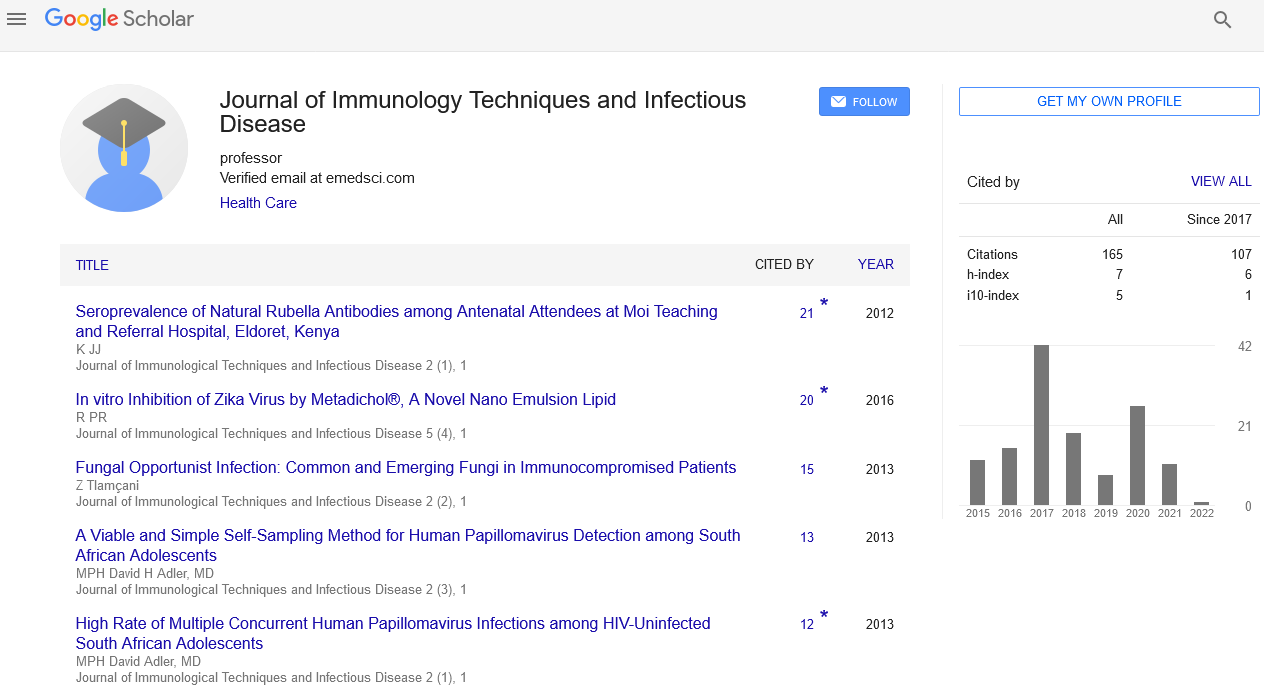Commentary, J Immunol Tech Infect Dis Vol: 13 Issue: 2
Global Health Challenges and Prevention Methods for Waterborne Disease
Dolma Hazarika*
1Department of Immunology, Sikkim Manipal University, Gangtok, India
*Corresponding Author: Dolma Hazarika,
Department of Immunology, Sikkim
Manipal University, Gangtok, India
E-mail: hazar.dol@gmail.com
Received date: 28 May, 2024, Manuscript No. JIDIT-24-146421;
Editor assigned date: 31 May, 2024, PreQC No. JIDIT-24-146421 (PQ);
Reviewed date: 14 June, 2024, QC No. JIDIT-24-146421;
Revised date: 21 June, 2024, Manuscript No. JIDIT-24-146421 (R);
Published date: 28 June, 2024, DOI: 10.4172/2329-9541.1000384.
Citation: Hazarika D (2024) Global Health Challenges and Prevention Methods for Waterborne Disease . J Immunol Tech Infect Dis 13:2.
Description
Waterborne diseases are infections caused by harmful bacteria that spread through polluted water. These diseases provide significant health risks, particularly in regions with inadequate sanitation and limited access to clean water.
Impact of waterborne diseases
Waterborne diseases are a major public health concern, affecting millions of people worldwide. They are responsible for a significant proportion of infectious diseases, particularly in developing countries where access to clean water and proper sanitation is limited.
Global health challenges
Some of the prevalent global health problems are:
Waterborne diseases contribute to high morbidity and mortality rates, especially among children under five years old. Diarrhoeal disorders mainly contribute to approximately 485,000 fatalities in this age can vary every year. The economic burden of waterborne diseases includes healthcare costs, lost productivity, and long-term impacts on cognitive development and education in affected children.
Transmission pathways
Waterborne diseases are transmitted through various pathways, frequently connected to inadequate water quality, sanitation, and hygiene practices. Drinking contaminated water is the most direct way of transmission for many waterborne pathogens. This can occur when water sources are contaminated with fecal matter containing pathogens. Swimming or bathing in contaminated water can lead to infections through ingestion or contact with mucous membranes and skin. Using contaminated water for washing food or cooking can introduce pathogens into the food supply. Lack of proper sanitation facilities leads to open defecation, which contaminates water sources and increases the risk of disease transmission.
Risk factors of waterborne diseases
The most important risk factors for waterborne disease are:
Lack of access to clean water: Populations without access to safe drinking water are at higher risk of waterborne diseases.
Inadequate sanitation and hygiene: Poor sanitation practices and lack of hygiene education contribute to the spread of waterborne pathogens.
Climate and environmental conditions: Flooding, heavy rainfall, and poor drainage can contaminate water sources and facilitate the spread of waterborne diseases.
Prevention and control measures
Preventing and controlling waterborne diseases require a multifaceted approach involving improvements in water quality, sanitation, hygiene practices, and public health initiatives. Waterborne diseases are caused by various pathogens, including bacteria, viruses, protozoa, and parasites. Each pathogen has specific characteristics and modes of transmission.
Bacterial pathogens
Certain strains of Escherichia coli O157 can cause severe gastrointestinal disease with diarrhoea, abdominal cramps, and vomiting. Contaminated water and food are common sources of infection. The bacterium responsible for cholera, vibrio cholerae, causes severe watery diarrhea and dehydration. Epidemics of cholera are typically associated with polluted water sources and inadequate sanitation. Salmonella organisms can cause typhoid fever and gastroenteritis. These bacteria are transmitted through ingestion of contaminated water or food.
Viral pathogens
A highly contagious virus that causes gastroenteritis, norovirus leads to symptoms such as vomiting, diarrhea, and stomach cramps. It spreads through contaminated water and surfaces. Hepatitis A Virus (HAV) causes hepatitis A, an infection of the liver. It is transmitted through ingestion of contaminated water or food, leading to symptoms such as jaundice, fatigue, and abdominal pain.
Protozoan pathogens
Giardia lamblia protozoan causes giardiasis, a condition accompanied by diarrhoea, stomach discomfort, and weight loss. It spreads through consuming water infected with Giardia cysts. Cryptosporidium organisms cause cryptosporidiosis, a diarrheal disease. The parasite is resistant to chlorine disinfection, creating it a challenge to control in water supplies.
 Spanish
Spanish  Chinese
Chinese  Russian
Russian  German
German  French
French  Japanese
Japanese  Portuguese
Portuguese  Hindi
Hindi 
